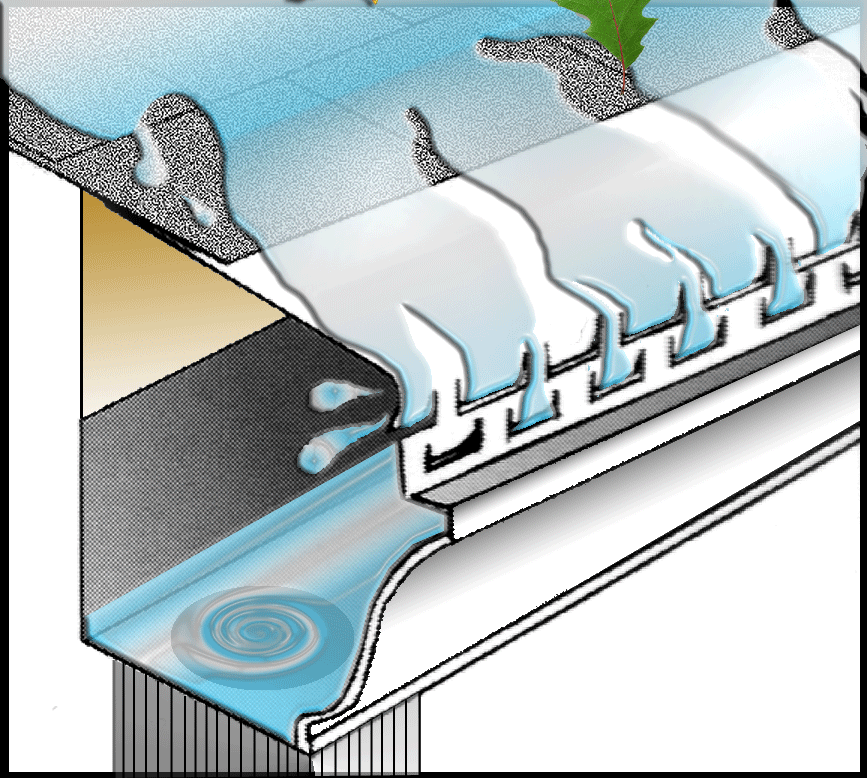How Waterloov Gutter Guards Work – Continued
 More about how Waterloov works.
More about how Waterloov works.
Rain water flowing from the roof carrying debris flows onto the top of the gutter protector which is angled to drain the water to the front of the panel where both the water and debris adheres to the surface of the gutter cover and flows down the front vertical surface of the protector. In cases where roof rafters are in excess of 35′ a high capacity panel which has a larger radius bend than the standard panel is used. A physical attribute called, “surface tension” causes it to adhere to the curved surface. However, the ability of water to do this is a function of the radius bend. For instance, the end of a standard board that you buy is a very tight radius and water will simply flow off into space. This is why some products overshoot — the radius bend is too tight. Waterloov is the only product available in standard and high capacity panels to accommodate large volumes of water flow. Most gutter covers (to this point work very much the same).The difference is in the collectors. Where most other gutter hoods or tops contain one longitudinal fin, Waterloov® has two rows of interspersed louvers. We call them discriminating louvers. The one long fin (louver that you find on other gutter hoods)can let in entire leafs that may be 8″or larger in width whereas the width of the Waterloov® opening is only 3/4″ thus discriminating the size that it allows into the gutter. Any water that doesn’t get caught by the first row of louvers flows down the bridge between the first row of louvers to the second row of louvers which are positioned directly under the bridge to collect the remaining water.Debris larger than 3/4″ in width can’t get through the openings. In fact for something 3/4″ width to get in, it has to hit the louver exactly at the right position which means that of the small amounts of debris that gets into the gutter, it is usually no larger than 1/2″ in width.
The journey isn’t over yet. We have the journey of the larger debris that doesn’t make it in and the journey of the small particles that do make it into the gutter.
The small amount of debris that manages to get through the louvers is swirled away. Because of the way water enters the gutter from the front wall of the gutter, swirling is created in the gutter which constantly moves that debris to the downspout and away.
The large debris that doesn’t make it has several fates:
1. Wind blows it away.
2. It will stick on the face of the louvers and here’s the amazing thing, the rainwater will actually flow under the debris and into the gutter even if the debris covers the louvers completely. Let me repeat that. Water actually prefers to adhere to the metal of the cover rather than skip to the top of the debris. After the rain stops, the debris dries and is often blown away. In situations where the debris does accumulate, suit and tie maintenance may be required a few times per year.
One additional benefit: Waterloov has what we call a wall of protection. Look at the other types of collectors and you’ll notice that there is nothing between the top lip of the gutter and the fin collector. This means that any debris (which can be substantial in quantity) that finds its way onto the gutter lip can be blown or washed into the gutter. Now take a look at Waterloov. Notice that there is a wall approximately 1/16″ in height between the top of the gutter lip and the bottom part of the lower row of louvers. This is the wall of protection that keeps debris from being blown or washed into the gutter. No other product gives you this protection.
Contrary to the hoods and topperss that can not be maintained from the ground, but require a service call, Waterloov® is worth 20 times the investment you would pay for those types of products, yet, Waterloov® is very comparable to them in cost.




